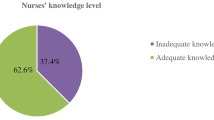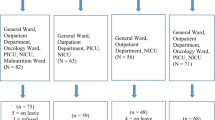Abstract
Pain management is an important issue which impacts the prognosis of neonates in neonatal intensive care units. Evidence has shown that professionals’ knowledge and attitudes regarding pain management can impact the quality of their practice. The purpose of this study was to evaluate the knowledge, attitudes, and practices of neonatal professionals regarding neonatal pain management. A cross-sectional study was performed involving neonatal physicians and nurses, using a research questionnaire to investigate the knowledge and attitudes of professionals as well as to assess their practice of pain management. Research found an apparent discrepancy between the knowledge levels of neonatologists and nurses regarding pain assessment and management, with nurses displaying weaker professional knowledge and more negative attitudes toward pain management than did neonatologists. Additionally, research revealed a lack of knowledge and negative attitudes among participants regarding the provision of sufficient opioid analgesics to sick infants during invasive procedures and even for dying neonates. There is an urgent need for continuing education regarding neonatal pain management with the goal of empowering neonatal professionals; further research is needed into the question of how to translate education into more reliable practice.
Conclusion: This research provides useful information regarding the knowledge, attitudes, and clinical practice of neonatal pain management among neonatologists and nurses and points out some differences in the knowledge levels of these two groups.
What is Known: •Neonates can perceive and respond to pain stimuli by showing their biological signals similarly to children and adults. •Untreated or insufficient pain management for high-risk neonates has short-term. negative effects and may also induce long-term negative effects. What is New: •The level of knowledge, the attitudes, and the practices regarding neonatal pain in intensive care are different among neonatal professionals. •There is an urgent need to provide interdisciplinary continuing education to improve the knowledge of neonatal professionals and encourage them to more highly prioritize neonatal pain management. |
Similar content being viewed by others
Abbreviations
- CVI:
-
Content validity index
- NICU:
-
Neonatal intensive care unit
References
American Academy Pediatrics (AAP) (2016) Prevention and management of procedural pain in the neonate: an update. Pediatrics 137(2):e 20154271
Harrison D, Bueno M, Reszel J (2015) Prevention and management of pain and stress in the neonate. Res Rep Neonatol 5:9–16
Grunau RE (2013) Neonatal pain in very preterm infants: long-term effects on brain, neurodevelopment and pain reactivity. Rambam Maimonides Med J 4(4):e0025. https://doi.org/10.5041/RMMJ.10132
Vinall J, Grunau RE (2014) Impact of repeated procedural pain-related stress in infants born very preterm. Pediatr Res 75(5):584–587
Simons SH, Van Dijk M, Anand KS, Roofhooft D, Van Lingen RA, Tibboel D (2014) Do we still hurt newborn babies? A prospective study of procedural pain and analgesia in neonates. Arch Pediatr Adolesc Med 157:1058–1064
Mancuso T, Burns J (2009) Ethical concerns in the management of pain in the neonate. Pediatr Anesth 19:953–957
Suciu LM, Cucerea M, Simon M, Avasiloaiei A, Petrescu O, Andrei SB (2015) Health care professional’s attitude towards the effective management of pain in the critically ill neonate. J Crit Care Med 1(3):107–112
Sujatha S, Samson R, Sundaresan (2015) Nurses knowledge and neonatal pain management. Int J Adv Res 3(8):732–737
Akuma AO, Jordan S (2012) Pain management in neonates: a survey of nurses and doctors. J Adv Nurs 68(6):1288–12301
Mehrnoush N, Ashktorab T, Heidarzadeh M, Momenzadeh S (2017) Knowledge and attitude of personnel, key factors in implementation of neonatal pain management in NICU: a qualitative study. J Clin Diagn Res 11(11):SC05–SC09
Tsao S-T, Hsieh Y-J (2015) Pain management experience at a Central Taiwan medical center. Acta Anaesthesiol Taiwanica 53:66–70
Taiwan Society of Neonatology. Recommendations for neonatal pain control and management. [Traditional Chinese Version]. 2018. March http://www.tsn-neonatology.com/upload/files/79.pdf
Peng N-H, Chen C-H, Liu H-L (2011) To explore the conditions of dying infants in NICU in Taiwan. J Crit Care 27(1):102.e7-13
Chen C-H, Huang L-C, Liu H-L, Lee H-Y, Wu S-Y, Chang Y-C, Peng N-H (2012) To explore the neonatal nurses' beliefs and attitudes towards caring for dying neonates in Taiwan. Matern Child Health J 17(10):1793–1801
Scholten W (2015) Improving access to adequate pain management in Taiwan. Acta Anaesthesiol Taiwan 53:62–65
Christoffel MM, Castral TC, Daré MF, Montanholi LL, Scochi CGS (2016) Knowledge of healthcare professionals on the evaluation and treatment of neonatal pain. Rev Bras Enferm 69(3):516–522
Khoza SLT, Tjale AA (2014) Knowledge, attitudes and practices of neonatal staff concerning neonatal pain management. Curationis 37(2):E1-9. https://doi.org/10.4102/curationis.v37i1.1246
Jeong IS, Park SM, Lee JM, Choi YC, Lee J (2014) Perceptions on pain management among Korean nurses in neonatal intensive care units. Asian Nurs Res 8:261–266
Pölkki T, Korhonen A, Laukkala H, Saarela T, Vehviläinen-Julkunen K, Pietilä A-M (2010) Nurses’ attitudes and perceptions of pain assessment in neonatal intensive care. Scand J Caring Sci 24:49–55
Maghami M, Aghababaeian H, Majin SA, Moosavi A, Tahery N (2016) Knowledge, attitude and performance of the nurses working in neonatal wards about treatment of pain in neonates. J Chem Pharm Sci 9(4):2796–2801
Hagy HN (2015) Pain management in the neonatal intensive care unit. Montview Liberty Univ J Undergrad Res 1(1):Article 4 http://digitalcommons.liberty.edu/montview/vol1/iss1/4
Panek M, Kwinta P (2018) Pain management and assessment in Polish neonatal units in the opinion of nurses and midwives. Pediatr Res Child Health 2(1):001–007
Shareena I, Flora NFE, Syed ZSZ, Adli A, Rohana J (2019) Neonatal pain: knowledge and perception among pediatric doctors in Malaysia. Pediatr Int 61:67–72
Hechler T, Kanstrup M, Holley AL, Simons LE, Wicksell R, Hirschfeld G, Zernikow B (2015) Systematic review on intensive interdisciplinary pain treatment of children with chronic pain. Pediatrics 136(1):115–127
Gomes Neto M, da Silva Lopes IA, Araujo ACCLM, Oliveira LS, Saquetto MB (2020 May) The effect of facilitated tucking position during painful procedure in pain management of preterm infants in neonatal intensive care unit: a systematic review and meta-analysis. Eur J Pediatr 179(5):699–709
Efendi D, Rustina Y, Gayatri D (2018) Pacifier and swaddling effective in impeding premature infant’s pain score and heart rate. Enferm Clin 1:46–50
Lima A, Santos V, Nunes M, Barreto J, Ribeiro C, Carvalho J, Ribeiro M (2017) Glucose solution is more effective in relieving pain in neonates than non-nutritive sucking: a randomized clinical trial. Eur J Pain 21:159–165
Funding
There is no funding source.
Author information
Authors and Affiliations
Contributions
N-H Peng contributed to study design, approval of the protocols of this study, data collection, and manuscript writing. Y-C Chang was responsible for data analysis and interpretation of research data. M-C Lee, W-L Su, C-H Lee, C-H Chen and C-H Huang contributed to data collection.
Corresponding author
Ethics declarations
Conflict of interest
The authors declare that they have no conflict of interest.
Ethical approval
This article includes a questionnaire study. The questionnaires were in accordance with the ethical standards of the institutional ethics committee (REC 104-37).
Statement of informed consent participation in the questionnaire after receiving the invitation implied consent. Informed consent was obtained from all individual participants included in the study.
Additional information
Editorial Responsibility: Gregorio Paolo Milani
Publisher’s note
Springer Nature remains neutral with regard to jurisdictional claims in published maps and institutional affiliations.
Rights and permissions
About this article
Cite this article
Peng, NH., Lee, MC., Su, WL. et al. Knowledge, attitudes and practices of neonatal professionals regarding pain management. Eur J Pediatr 180, 99–107 (2021). https://doi.org/10.1007/s00431-020-03718-0
Received:
Revised:
Accepted:
Published:
Issue Date:
DOI: https://doi.org/10.1007/s00431-020-03718-0




